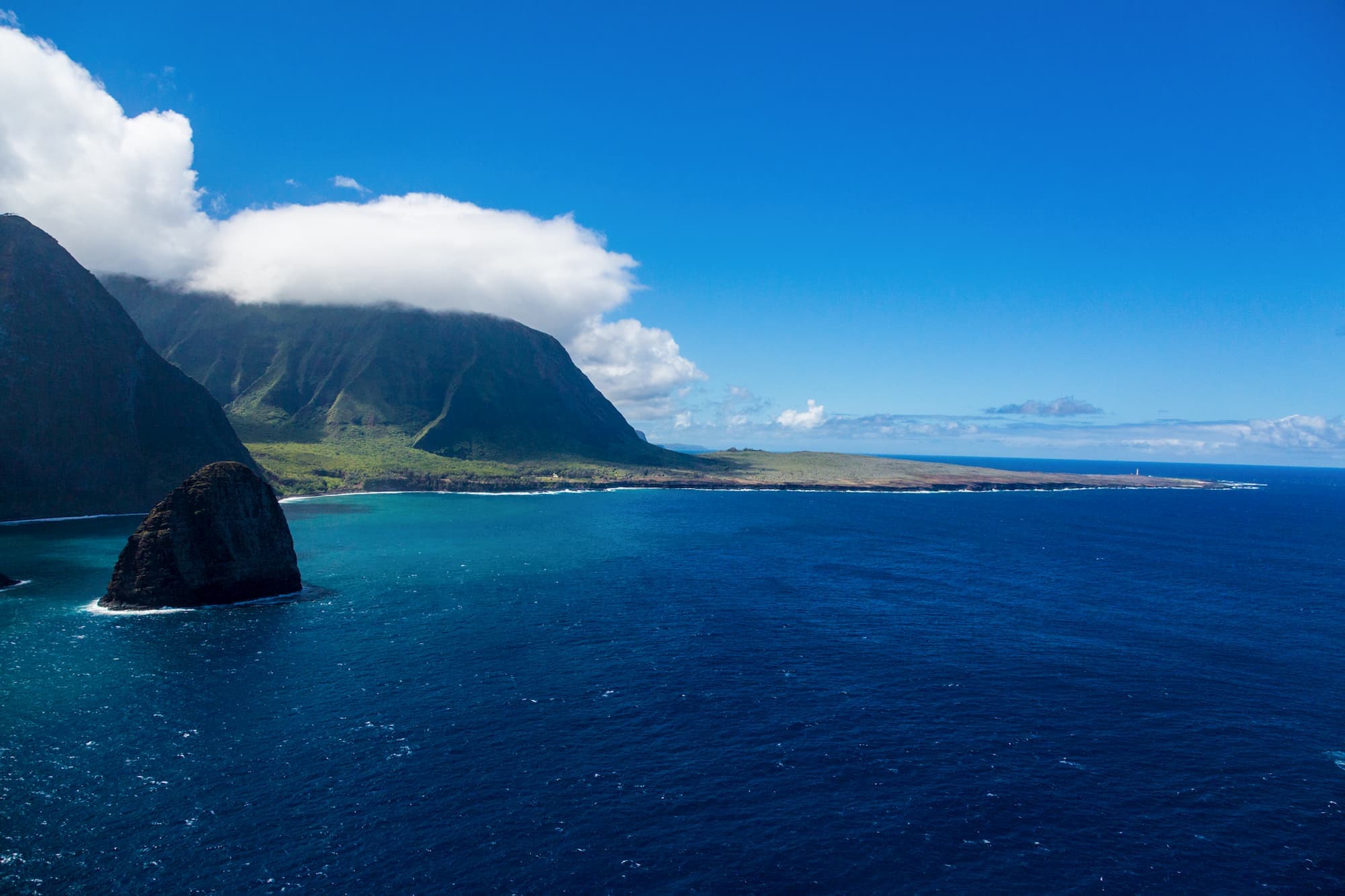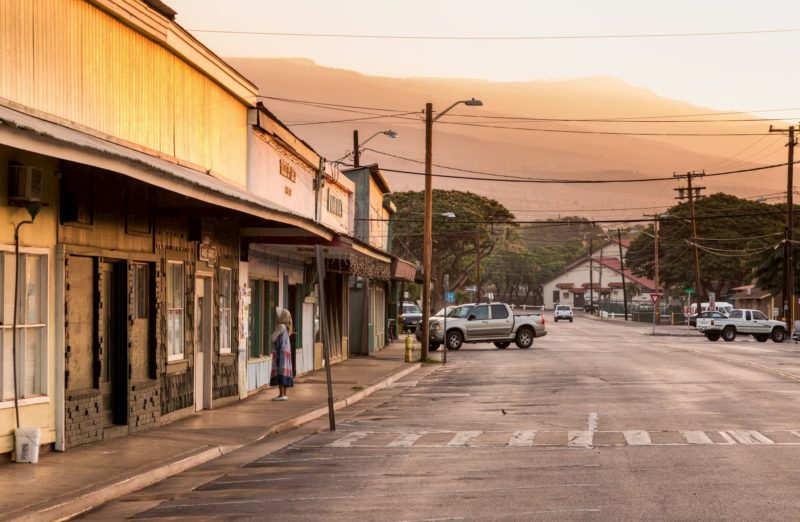Of the major Hawaiian Islands, Molokaʻi stands out as the least developed and the least influenced by tourism. Oʻahu is home to a major international city; Maui, Kauaʻi, Big Island, and Lānaʻi all have major tourist centers and/or luxury resorts built upon them. In this way, no island embodies the spirit of “old Hawaiʻi” quite like Molokaʻi, where there is but one small hotel, no traffic signals, and a strong, historical skepticism associated with mass tourism.
Indeed, if you’re looking to be whisked away from reality, or for fanfare, you should probably choose another island. Molokaʻi welcomes visitors with an open heart, and, as you’ll see below, it does have many “tourist-friendly” areas to visit, plenty to keep you busy for several days, in fact, including one of the state’s longest beaches and most-intriguing historical sites.
But the locals on Molokaʻi want your visit to be more than sightseeing and box-checking. You should be ready for a different kind of experience, one that reflects travel more than it does vacation.
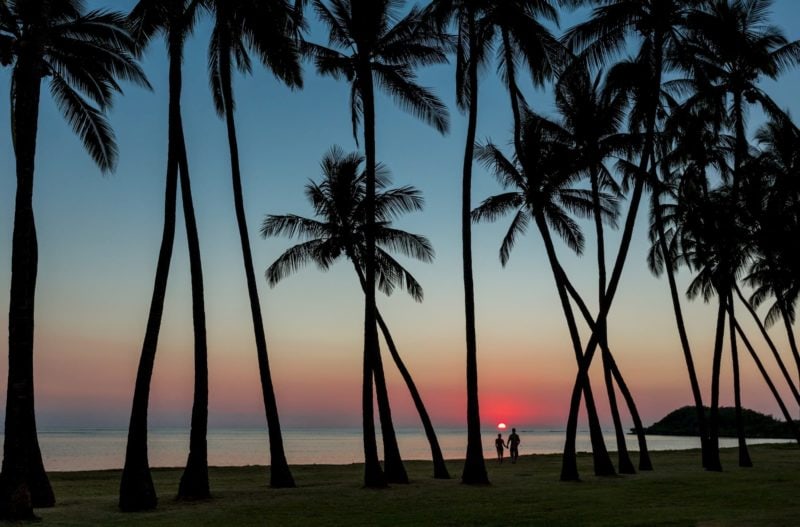
Visitors to Molokaʻi will find plenty of space to spread out. But Molokaʻi also wants its visitors to take an interest in the island’s local communities, creating a “mutually-beneficial” tourism experience. Credit: Hawaii Tourism Authority (HTA) / Tor Johnson
What to Know Before You Go
Over the decades, Molokaʻi has struggled with the idea of mass tourism. Time and time again, someone comes along and tries to commercialize the island, be it a big cruise ship company or a prospective developer. As you’ll see when you visit, none have succeeded, and understanding this dynamic is imperative to a mutually-beneficial visit.
Those words aren’t ours; in fact, the idea of a “mutually-beneficial experience” comes directly from the Molokaʻi tourism board. Instead of transactional tourism, Molokaʻi strives to create experiences that connect and bond visitors with the local communities and their initiatives. In other words, this is the island to visit if, instead of observing a community, you wish to take part in it.
With that in mind, don’t be surprised if you hear stories or see anti-tourism signs on your visit to the island. These proclamations are made against exploitation, not against heartfelt, genuine visitors. If your intention is to see the “real Hawaiʻi,” and to connect with real Hawaiians, Molokaʻi will become your favorite island in short order.
In the following video you can see and hear why cultural practitioner Greg Solatorio, who lives off the land on the island of Molokai following in the footsteps of his ancestors 1,000 years ago, has chosen to perpetuate his culture by sharing it with visitors:
Where to Stay
If deciding where to stay usually causes you stress, breathe easy – choosing your accommodation is easier on Molokaʻi than any other island thanks, simply, to the extremely limited number of options. There’s only one hotel, and beyond that, just a few vacation rental and volunteer opportunities to consider.
Below, we break down the pros and cons, and provide context of each.
Hotel Molokaʻi
The Hotel Molokaʻi has undergone several renovations in recent years, refreshing its rooms and common areas, including the outdoor space, pool area, restaurant, and bar. It has the honor of being the only hotel on the island and boasts an ocean-front location.
There are a variety of room types – some with kitchenettes – and most have their own patios. The property is lush and green, and the views from the bar and restaurant showcase calm waters, the island of Lānaʻi, and a vantage point of the sunset. There’s a small beach that comes and goes with the tides, suitable for sunbathing, but the ocean there is not swimmable, as it is rather shallow and muddy. To swim, guests will be directed to another nearby beach, either farther east or perhaps in Kaunakakai. It’s just a five-or-ten-minute ride into town, and the hotel provides a $5 shuttle with on-demand delivery into town.
Vacation Rentals
There are many vacation rental opportunities on Molokaʻi, some available via AirBnb/VRBO and others managed by local companies. A good place to start is Molokaʻi Vacation Rentals. They have condo communities throughout the island with well-appointed grounds and amenities, such as Wavecrest or Kepuhi, although keep in mind that they don’t offer the same in-house services as the Hotel Molokaʻi.
Volunteer Lodging
There are farms and other organizations on Molokaʻi that will provide free or discounted lodging in exchange for volunteer work. For those looking to make a strong connection with a local host and/or organization, this is a great opportunity. The Hālawa Flower Farm, for example, offers on-site lodging on its tropical farm in exchange for a half day’s work. The Kalaupapa Peninsula (more on that below) also has a volunteer program that provides lodging. Other volunteer opportunities can be found by contacting the Molokaʻi Tourism Board. They can help you match your interests (environmental, cultural, etc.) with the appropriate organization.
Camping
There are four camping areas on Molokaʻi: Papohaku Beach, Hālawa Valley Beach Park, One Aliʻi Beach Park, and Palaʻau Park. All require permits, obtainable at the office in Kaunakakai, which cost only $3 a night.
For coastal camping, our recommendations would be Papohaku Beach or Hālawa Valley. Both provide opportunities for swimming (when conditions allow) and offer serene oceanside settings.
For something different, Palaʻau Park is located in the mountains and offers tent sites in an ironwood grove. There are trails nearby, as well as a lookout over the Kalaupapa Peninsula.
You can read more details about camping on Molokaʻi and obtaining permits here.
Things to Do
Molokaʻi’s offerings are extremely diverse for a small island, and they are also very intimate and personal thanks to the locals’ authentic, genuine hospitality. Below, we provide a breakdown of the island and how to explore it.
- Kaunakakai and the South Shore
- Papohaku Beach and the West Side
- Hālawa Valley and the East Side
- Kalaupapa and the North Shore
- Farm Tours
- Volunteer opportunities
Kaunakakai and the South Shore
The main town of Molokaʻi is Kaunakakai. Here, you will find the island’s only gas stations and grocery stores, and if you want something on Molokaʻi, this small town is the only place to find it. In a section below, we highlight some of our favorite places to eat and drink.
One way to explore Kaunakakai (and perhaps commute back and forth between the Hotel Molokaʻi and the town) is by bike. Stop by Molokaʻi Bicycle and meet owner Phillip Kikukawa. You can rent a bike there, of course, and be sure to inquire about any evening rides that might be taking place (these are led by Phillip and are typically impromptu/by request). The shop can advise you about scenic rides on the island as well. Our favorite is riding from Kaunakakai east towards Hālawa.
On one of your first days, we recommend you check out the Molokai Museum & Cultural Center. It’s not far from Kaunakakai, and it offers an overview of Molokai and its history.
Papohaku Beach and the West Side
Drive west from Kaunakakai and you’ll head towards the western, dry side of the island. It’s where you’ll find the three-mile long Papohaku Beach, one of the longest white-sand beaches in all of Hawaiʻi. If you’re looking for serenity, and space to spread out, this is the place to find it, as it is typically only dotted with visitors. It’s a great place to find yourself during the sunset (it faces west), and once the sun goes down, you’ll be able to see the lights of Oʻahu across the way on a clear night.
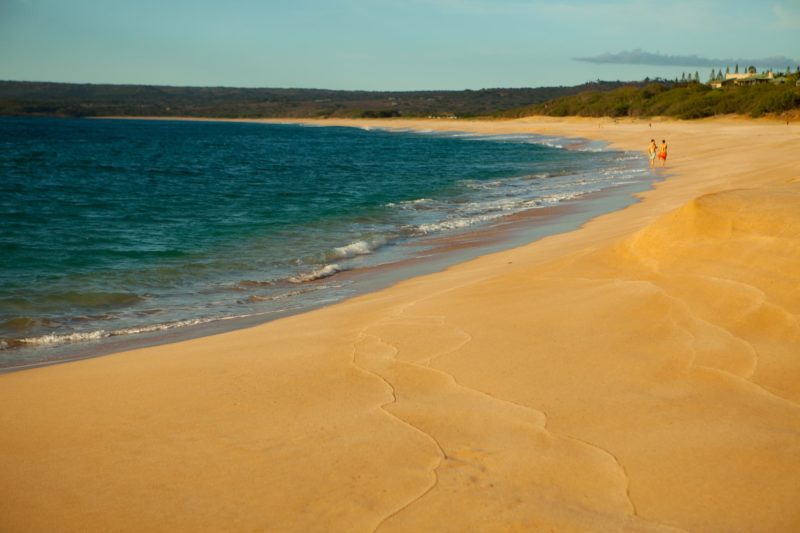
Papohaku Beach is one of the longest white-sand beaches in all of Hawaiʻi. Credit: Hawaii Tourism Authority (HTA) / Dana Edmunds
Hālawa Valley and the East Side
From Kaunakakai, take the road east and you’ll transition from the dry, southern shore to the wet, lush valleys of the island’s east end. The drive is incredibly scenic – it’s also a great bike ride – and it will take you through residential areas, past beach parks, and eventually, the road will hug the coast, following the ups and downs of the rocky shoreline. The views are spectacular, and one should make the drive regardless of the destination.
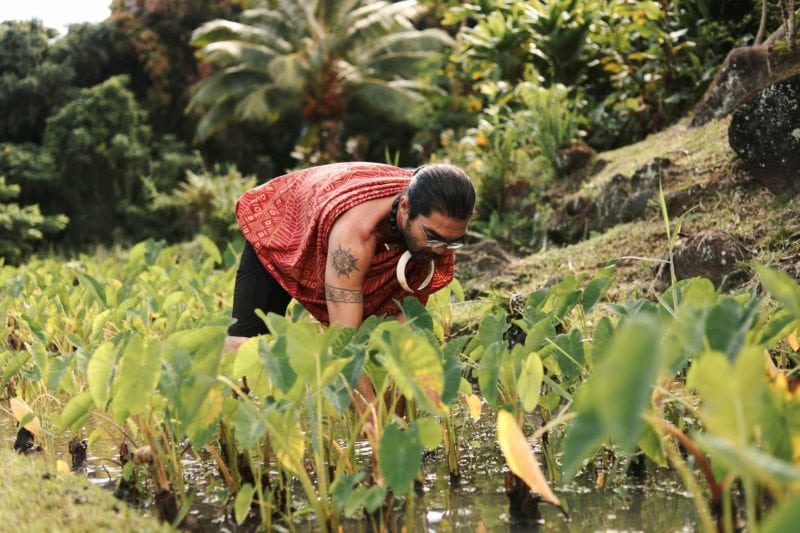
Greg Solatorio works on his taro field in Hālawa Valley. He often leads the Hālawa Valley Cultural Hike, which introduces visitors to the history and cultural significance of the valley. Credit: Hawaii Tourism Authority (HTA) / Brooke Dombroski / @brooklynhawaii
At the end of the road sits Hālawa Valley. It’s famous for a couple reasons. For one, it’s ridiculously beautiful, a deep, lush valley with streaming waterfalls, agricultural fields, and a unique, twisting-shaped beach park. Culturally speaking, it sits at the heart of Old Hawaiʻi. It was featured in the Sons of Hālawa documentary, highlighting the Solatorio family and their path to keeping the valley’s sacred history alive in the modern world. It’s absolutely worth a watch before visiting to understand its history, which is deep and sometimes dark – the valley was steamrolled by a legendary tsunami in 1946, reported to have waves up to 100 feet high.
When you go, there are a couple ways to experience both the past and present of Hālawa.
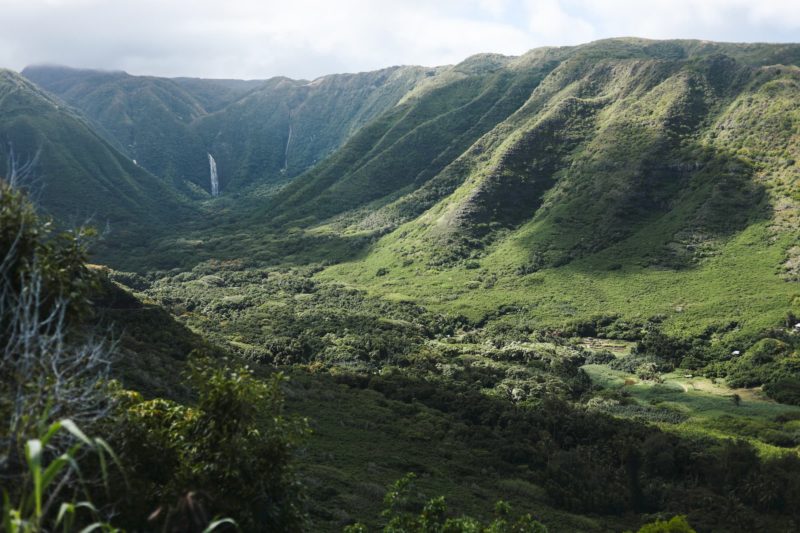
Halawa valley is a historic Hawaiian valley with towering waterfalls. Hawaii Tourism Authority (HTA) / Brooke Dombroski / @brooklynhawaii
Hālawa Valley Falls Cultural Hike
In an effort to continue the spread of Hawaiian culture and history in Hālawa Valley, the Solatorio ohana (family) offers a waterfall hike and cultural presentation aimed at educating and delighting visitors simultaneously. The experience includes cultural rituals and a hike to the back of the valley, where you’ll get the chance to swim in an otherwise-private waterfall (the waterfall is located on private property, so you cannot reach it without being on this tour, or the one below). We highly encourage this tour, as it is one of the best mixes of culture and adventure in all of Hawaiʻi. It’s especially rewarding if you’ve watched the documentary beforehand and come with the intention of learning more from the Solatorio family.
Hālawa Valley Flower Farm & Waterfall Hike
There’s another tour in the valley that will also take you to that private waterfall, and this one is run by the Hālawa Valley Flower Farm. The tour centers around the lush, tropical gardens and the cultivation of native fruits and plants, complete with a fresh smoothie and a dip in the waterfall. We recommend this tour for natural and botanical enthusiasts.
Hālawa Valley Beach Park
Though much of Hālawa Valley is private property (please respect all no trespassing signs), the beach park is public, and you are free to visit and explore. It’s a great, tropical contrast to Papohaku Beach Park, and we recommend spending a morning or afternoon here to take it all in, perhaps before or after one of the above tours.
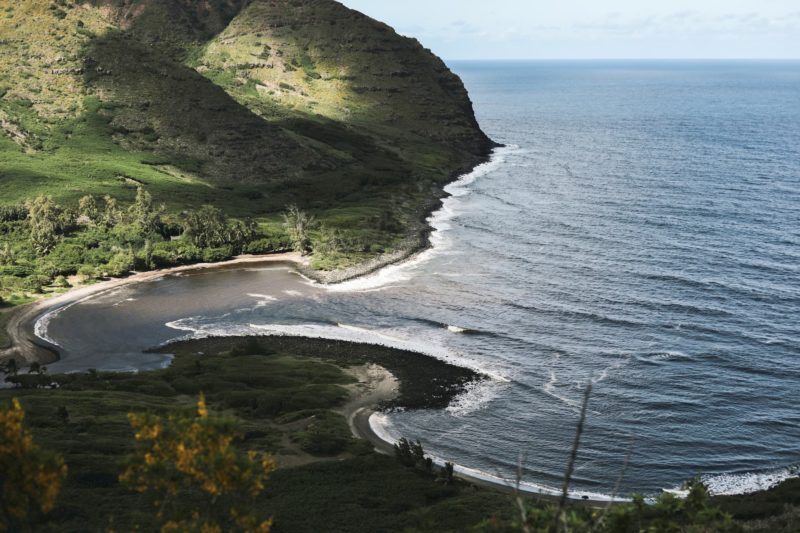
Hālawa Valley Beach Park from the overlook. Credit: Hawaii Tourism Authority (HTA) / Brooke Dombroski / @brooklynhawaii
Kalaupapa and the North Shore
Molokaʻi’s North Shore is home to gigantic 3,000-foot sea cliffs – some of the tallest in the world – with small valleys and massive waterfalls creating its idyllic image. Most of it is undeveloped, experienced only by boat or plane, similar to Kauaʻi’s Na Pali Coast.
But there is one very special area on the North Shore that’s inhabited and open to visitors – the Kalaupapa Peninsula, also known as the Kalaupapa National Historic Park. It’s not only the most famous place on Molokaʻi, but one of the most historical places in the entire island chain.
In the mid-1800s, a leprosy outbreak took place in Hawaii, which resulted in King Kamehameha V banishing all those infected with the highly-contagious disease to the remote Kalaupapa Peninsula. It was considered the perfect sanctuary, surrounded by towering sea cliffs and the rough ocean – a golden cage, if you will.
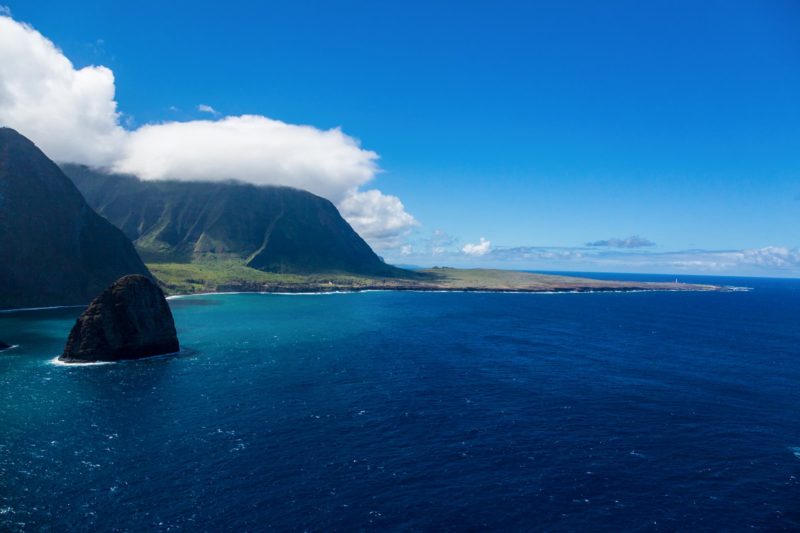
Sea cliffs at the Pali coast with Kalaupapa in the distance. Credit: Hawaii Tourism Authority (HTA) / Tor Johnson
Unfortunately, the story doesn’t have such a happy ending. More than 8,000 people died at Kalaupapa from the disease, including one very famous saint, Father Damien. Today, Kalaupapa remains home for a handful of patients who still live with the disease (they are “cured,” but have no place back in the “real world”). It is managed by the National Park Service, and it’s possible to visit on a tour to learn more about the community and its history.
Previously, there were multiple ways to access the Peninsula, including on foot, via mule, or by flying in to its small runway. However, a 2019 landslide destroyed the trail, eliminating foot and mule access for the time being. At the moment, the only way to visit the peninsula is by plane, either from Molokai airport or as a day trip from another island. For more information, contact the Park’s tour vendor, Father Damien Tours, for the latest information and options, as it changes quite frequently.
Farm Tours
Molokaʻi is a producer of several Hawaiian products, including plumerias, macadamia nuts, flowers, and coffee. Its coffee farm recently closed indefinitely (you should still be able to find Molokaʻi coffee for sale, however), but others remain open for visitation.
Molokaʻi Plumeria Orchard
Plumeria’s are arguably the most popular flower in Hawaii, offering a beautiful combination of soft colors and a sweet, unmistakable smell. It’s why they are so often used in lei-making, and if you’ve been to Hawaiʻi before, you’ve probably worn them in your hair or around your neck. A visit to the Molokaʻi Plumeria Orchard gives you the chance to see how they are grown (on trees), how they are harvested and sold, and how to make your own lei out of the flowers.
Purdy’s Natural Macadamia Nuts
Ever try raw macadamia nuts? Do you know what it takes to crack their shells? Purdy’s provides a real look at a working macadamia nut farm, with little to no fanfare. Learn how they are produced, the history of the macadamia nut on Molokaʻi, how the taste changes when they are roasted, and most importantly, the lifestyle of the farmers.
Hālawa Flower Farm Tour
As previously mentioned, this flower farm offers tours of its gardens as well as a waterfall hike and fresh smoothies.
Volunteer Opportunities
Molokaʻi is interested in visitors who want to take part in the island’s culture, learn about its way of life, and make a lasting impact and connection with its residents.
Almost any farm on Molokaʻi is open to volunteer arrangements, all one has to do is contact them to set it up (details of each will be slightly different). In addition to the farms above, we recommend inquiring about opportunities with the Mokio Preserve (via the Molokai Land Trust) and the Moʻomomi Preserve (run by the Nature Conservancy).
Food and Drink
The only restaurants on the island are in Kaunakakai. Options are limited, and here’s what we suggest:
Kanemitsu Bakery (and the famous “hot bread”)
During the day, Kanemitsu is the island’s beloved bakery and breakfast shop, located in the heart of downtown Kaunakakai. Stop by in the morning for a coffee and pastry, keeping yourself open to interactions with the many locals who frequent it.
At night, you’re in for a different treat. The front of the bakery closes well before nightfall, but once darkness settles in, a “secret” window behind the restaurant opens up, and its famous “hot bread” becomes available – a warm, fluffy loaf of French bread lathered with your choice of filling, typically a combination of cream cheese and your choice of blueberry, strawberry, or guava jam. This bread is a must-try, but it is very big, so it’s advisable to split it with someone else. Exact hours for the hot bread tend to change often, so inquire with a local once on-island.
Paddler’s Restaurant and Bar
If you’re looking for a spot to grab a happy hour drink and dinner, check out Paddler’s. It’s a basic restaurant – stick to beer, simple mixed drinks, burgers, and local fish plates – but it’s one of the best places to mingle with locals and open yourself up to interactions. Some nights are particularly good, such as when the local musicians come together for kanikapila, an impromptu, cultural, live performance typically held at family gatherings.
Give Paddler’s a call when you’re on island to see which night it will take place, and don’t miss it.
Hotel Molokaʻi
The bar and restaurant at the Hotel Molokaʻi is the only waterfront restaurant on the entire island. Whether you are staying at the hotel or not, it’s a solid place to have dinner and drinks, especially during the sunset.
Getting Around
Realistically, you’ll need to rent a car when you’re on Molokaʻi, as it’s the most efficient way to explore the island in a reasonable amount of time. Alamo is the only company at the airport, and the rates are expensive – at least $75 a day for a compact car. But, there are other options, such as the Molokaʻi Car Rental, which offer lower rates of $35 a day or $175 a week, although these cars tend to reflect the price, with some dings and sometimes without air conditioning. Be sure to inquire when booking to know what you’re getting.
Getting to Molokaʻi
You can get to Molokaʻi by air only. The ferry from Maui has been out of operation since 2016.
